
Fish species on brink of extinction as water quality declines
Textbooks used in middle schools often call the Yangtze River one of the Mother Rivers of China as it has 49 tributaries, each with a drainage area of more than 10,000 square kilometers, and hundreds of attached lakes.
It is home to 424 types of fish, of which 183 are endemic, and the categories of freshwater fish in the river comprise 33 percent of the national total.
But President Xi Jinping has said that the country's longest river is almost a "fish desert".
In an April meeting in Wuhan, Hubei province, that focused on the Yangtze River Economic Belt, the president said the bio-integrity index of the Yangtze has reached the "no fish" level. This means that the river's water ecology has fallen to its lowest biodiversity level.
Six months later, the State Council, China's Cabinet, urged local governments to strengthen protection of aquatic species and accelerate restoration of the Yangtze's ecological environment.
The 6,380-kilometer waterway is the third-longest river in the world - after the Nile (6,670 km) and the Amazon (6,400 km). The Yangtze has a total drainage area of 1.8 million sq km, home to a population of some 400 million people.
Over the past 20 years, the urban area located in the river's drainage basin has increased by about 40 percent.
But a high population and economic burden has taken its toll.
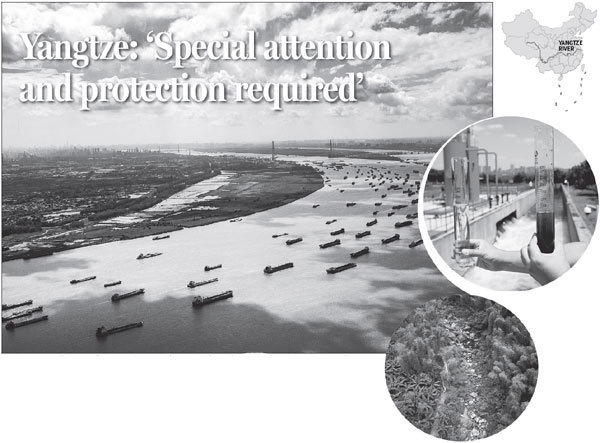 |
|
Clockwise from above: The Wuhan section of the Yangtze River; a worker compares differences in water quality at a sewage treatment plant in Chongqing; a nature reserve stands alongside the Chishui River, one of the Yangtze’s tributaries, in Guizhou province. Photos by Xiao Yijiu and Jin Liwang / Xinhua |
The Yangtze River Dolphin was declared functionally extinct in 2006, there were only about 1,000 finless porpoise remaining in the Yangtze by the middle of this year and the Chinese paddlefish has not appeared in the river since 2003.
The Chinese sturgeon, Chinese sucker fish, Chinese rock carp and Dabry's sturgeon - all endemic to the Yangtze - are also on the brink of extinction.
Cao Wenxuan, an academician specializing in aquatic organisms in the middle and upper reaches of the Yangtze with the Chinese Academy of Sciences, said the waters in these reaches of the river are home to 43.3 percent of 124 types of endemic fish, so they deserve special attention and protection.
According to experts, excessive and disorderly development of water control projects has had the "gravest influence" on the waterway's ecology.
On June 19, the National Audit Office issued a report on the ecological environmental protection of the Yangtze River Economic Belt.
The report shows 24,100 small hydropower stations have been built along the streams and tributaries of the Yangtze in 10 provinces, of which 930 were completed before passing an environmental impact assessment. It also indicates that excessive development has caused runoffs to varying degrees in 333 rivers in the Yangtze drainage area.
Runoffs refer to the amount of precipitation on land that ultimately reaches streams often with dissolved or suspended material.
A national project proposed in the 1960s was launched in the '90s to transfer water and thermal power from western inland areas to coastal regions to meet the latter's fast-rising demand for electricity. Many hydropower stations were built in the '90s and early this century in the Yangtze's drainage area.
Cao said many of these power plants were built on second-or third-class tributaries, and the installed capacity at some is only hundreds of kilowatts.
The stations helped to alleviate the energy shortage in the 1980s and '90s. But there are so many of them that they often cause drastic changes to runoffs in the rivers.
"The income from power generation is probably not enough to cover the losses from ecological damage to the waters," Cao said.
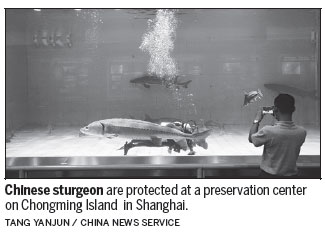
Chen Yiyu, a research academician at the Chinese Academy of Sciences who studies aquatic species, told Caixin Magazine, "The problems include construction of water conservancy projects, disconnection of rivers and lakes, over-fishing, water pollution and invasion of alien species.
"The rich aquatic biodiversity of the Yangtze is closely related to the flood plain environment and seasonal flooding on the middle and lower reaches of the river. But human activities have changed all these factors."
Chen said there are more than 50,000 dams, of which 20,000 are hydropower stations, in the drainage basin of the Yangtze, and these have had a grave impact on the aquatic environment.
Cao does not think that fish can survive in the reservoirs that have been built alongside the dams, and that measures that have been taken cannot restore the waterway's ecology.
"It is a waste of time and money. Species cannot be effectively protected at all," he said.
Joint declaration
Wan Chengyan, a researcher with the Ministry of Water Resources on water projects and ecology, said the main problem facing the Yangtze is the "obstruction of dams and fragmentation of the biological environment".
Aquatic species in the river and its tributaries have been separated by the dams, and some cannot spawn at their original sites. Although some species have been forced to find new sites, their breeding scale is quite limited.
Wan said the large number of dams built along the Jinsha River (the name for the upper reaches of the Yangtze) and its tributaries has downgraded the water ecology, and many types of fish that require a certain area of running water to spawn in cannot survive.
"The dams have not only changed the original state of the river, but also delayed change in the water temperature immediately downstream from the dams. Both factors directly affect fish spawning," Wan said.
According to experts, the artificial separation of lakes and rivers along the waterway is also contributing to the ecological downgrading.
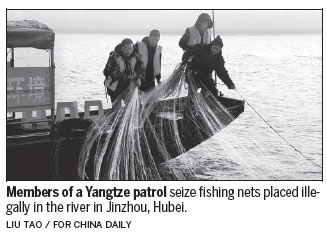
Governments at various levels have realized the urgency of the issue. At a conference in Wuhan, Central China's Hubei province, on Nov 3, five ministries and 15 provincial-level regions jointly issued a declaration on the river's ecological protection.
At the conference, Minister of Agriculture and Rural Affairs Han Changfu vowed to "resolutely reverse the ecological recession trend and provide powerful support to the protection and ecological restoration of the mother river".
Thousands of fishermen have lived on their boats on the Yangtze for generations. But now the government needs to create new jobs for them on land, due to depletion of the fish population.
According to Chen, 34.14 million fries of rare fish species, including the Chinese sturgeon and common sucker fish, and 12.93 billion fries of the black, grass, silver and bighead carp were introduced to the Yangtze from 2015 to 2017, playing an important role in maintaining and boosting the fish population.
But Cao said it is almost impossible for the river's ecology to recover as a whole.
"However, it is still possible to restore the ecology in some tributaries where endemic fish live," he said.
The Chishui River, a 436-km-long first-class tributary of the Yangtze, is one of the few rivers of such scale where a big dam has not been built.
"It flows naturally, boasts a complete and healthy water ecology system and is home to a great variety of aquatic organisms," Cao said.
Experts think the Chishui River is an example of the possibility of achieving balanced development.
Chishui city, Guizhou province, which is named after the river, has not only moved its limited number of industries to an industrial park to collectively process their waste, it has also helped farmers to select more-profitable environmentally friendly plants to reduce the effects of the use of pesticides and chemical fertilizers on the environment.
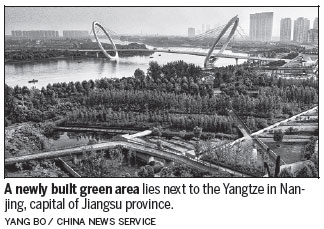
Xie Yuanchi, the deputy mayor of Chishui, told the media that the farmers - some of whom still live a hand-to-mouth existence - are encouraged to plant dendrobium stem (a kind of herb), bamboo and nursery-grown plants and raise fish and chickens.
Last year, the ecological farm industry and environmentally friendly industries contributed 75 percent of the city's GDP, proving that backward inland regions can overcome their reliance on polluting industries to boost economic growth and strike a balance between social, economic and ecological needs.
Xie said the well-protected environment now attracts tourists from across the country, who made 16.35 million trips to the city last year, nearly four times the number four years ago.
Technology upgrades
Similar examples can be found in Yunnan, Sichuan, Hubei and Hunan - inland provinces on the middle and upper reaches of the Yangtze that used to settle for the "pollute-first, clean-later" development model of wealthier coastal regions.
Yichang, a regional chemical industrial center in Hubei, has closed 25 chemical engineering factories and 206 mining enterprises since 2016. It will ensure all chemical enterprises' emissions reach national standards by upgrading technology, and relocating them to industrial parks far from the Yangtze.
Although these efforts have been praised by environmental experts, Cao suggests that dismantling all small hydropower stations in the drainage area of the Yangtze is the most effective way to restore the river to its original state. Meanwhile, new natural reserves should be established to highlight the river's ecological functions in water purification and maintaining biodiversity.
In June, the Ministry of Ecology and Environment vowed to strengthen the environmental impact assessment of small hydropower stations in the Yangtze River Economic Belt, and to suspend the construction or expansion of such stations in the 11 provinces in the belt in the second half of this year.
President Xi said during his visit to Chongqing in January 2016 that protecting the Yangtze's ecology and environment must be regarded as the most important task. There should be concerted efforts on systemic protection, and no major development along the river.
Muhe is a migrant village in the Fuling district of Chongqing on the banks of the middle reaches of the Yangtze, with most villagers coming from areas flooded for the Three Gorges Reservoir. They plant fruit trees, including loquat, litchees, longan and oranges.
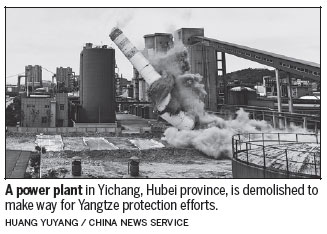
Liu Jiaqi, Party secretary of the village, has another title - "river chief" - and is responsible for protecting the more than 1 km section of the Yangtze that passes through Muhe.
Early last year, Liu found a pickled vegetable factory in the neighboring village of Linfeng was suspected of discharging waste water into the Yangtze. He contacted the "river chief" in Linfeng, who ordered the factory to dismantle a newly built drainage outlet.
Liu, who met with Xi during the latter's visit to Chongqing, said that as the president stressed, "we shoulder heavy responsibility to protect the mother river", and it will take the joint efforts of the tens of thousands of grassroots "river chiefs" in the Yangtze drainage area to make a difference.
Sewage from the village used to be directly discharged into the Yangtze. Now, every family has been provided with underground tanks to collect biogas, with help from the local government. The tanks collect sewage and produce methane for use as fuel, with the residue used as fertilizer.
To protect the Yangtze's ecology, the county government in Yunyang, Chongqing, suspended a chemical engineering project that was under construction.
If completed, the project would attract investment of billions of yuan and generate 1 billion yuan ($143 million) in tax revenue a year.
Zhang Xuefeng, Party chief of Yunyang, told the media that although the project would be a big boost for the local economy if completed, "we cannot ignore its impact on the environment, and we must prioritize ecological protection".
Some of the efforts made along the Yangtze have paid off. By the end of last year, there were 896 nature reserves, covering an area of more than 78,000 sq km next to the waterway, of which 385 are protection zones for aquatic species.
According to the Academy of Social Sciences of Shanghai, improvements made to the water quality in the river's drainage area have been the fastest among all major rivers in the country.
The air quality index, sewage water treatment, residential and industrial waste treatment and green coverage ratios of the 110 major cities in the Yangtze River Economic Belt are all markedly above the national average, although there is potential for further improvements.
Despite this, experts warn there is still a long way to go in transforming the river from being a fish desert to a fish paradise, as some of the changes it has seen are almost irreversible.